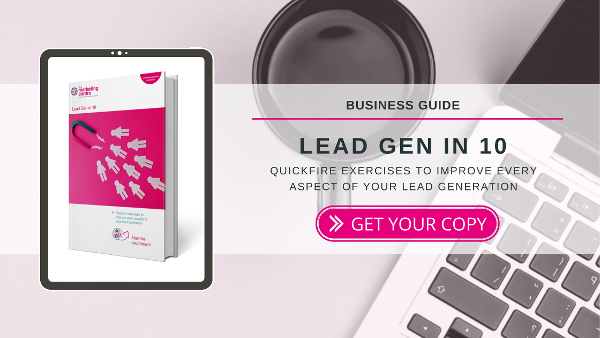It’s easy to rush straight into appointing an agency when you want to rebuild your website. However, appointing an agency before understanding what you need from your website is like deciding on the colour scheme before the foundations have even been laid.
Web creative agencies are experts in their trade, but without a solid brief to work with, they’ll never create your perfect website.
Get it right the first time by answering these 24 questions. They’ll help you to lock down the fundamentals of your new website, and how you’ll make them happen.
Business objectives
What is your website for? / What are you trying to achieve?
Are you looking for a lead generation machine, or creating a source of information? Will you use the site to build a community, or to take on elements of tasks like customer service? Are you targeting a new audience, or do you just want to better serve your existing audience?
Defining the purpose of your website should be the first step. Consider drawing up a list of possible purposes and decide which to prioritise.
You’ll most likely have multiple goals. Defining and ordering these in terms of priority will give you the clarity you need.
How does your website support business growth?
Be as clear and specific as you can. ‘Generating new leads’ is too vague to be useful for your agency. A much better answer would be:
- To make it easy for our customers to find our business using search engines
- To share useful and informative information with them so they can decide whether we’re the right fit
- To quickly and easily book a 20-minute discovery call with Michelle so she can qualify the opportunity (or not)
The more specific you are about your business goals, the better your agency brief will be.
What are the KPIs/success criteria for this rebuild?
SMART goals - specific, measurable, attainable, realistic and time-sensitive - will determine whether your rebuild is a success. The KPIs/success criteria that you choose will depend on your objectives. For some, it may simply be increased traffic or newsletter sign-ups. For others, it may be higher sales volumes.
5 quickfire exercises to improve every aspect of your lead generation
Everything you need to know about generating more leads. Get our Lead Gen in 10 workbook today.
What has and hasn’t worked so far
What’s working and not working at the moment?
List the things you want to keep as well as those you don’t. Take every aspect of your website into account, from the design through to the back-end functionality to the management.
Conversion rates or session times may be below what you are aiming for. Your current site may be clunky or difficult to update. Listing the negative aspects of your existing website - which may come from internal or customer feedback - will give you a solid understanding of what needs to change. Listing the positive aspects will inform what to keep.
These two lists will help answer the next question.
Rebuild or redesign?
If the list of what’s broken is significantly longer than the list of what isn’t, you might be best off with a complete rebuild. Likewise, if the problem areas are mostly cosmetic or isolated to specific things, a touch-up or redesign might work fine (and save you some money).
What’s missing?
There are many things that a website can do - but this doesn’t mean that your website should do everything. Using the objectives you set at the start, establish which missing elements will actually help you reach your goals.
What’s made you think ‘we need a new site’?
Designing a website from scratch is a far bigger leap than modifying an existing site. A clear definition of your reasons for needing something totally new will help the design team to paint a clear picture.
A redesign due to a company merger and a need for consistency, for example, will be entirely different from one needed purely to improve the user experience.
What can you learn from existing analytics?
Your existing website’s analytics can tell you a lot about what currently works and what needs improvement. For example:
- Traffic volumes: How successful is your website at attracting your target audience? What are your key channels?
- Entry and exit points: What content is proving most popular, which needs work?
- User journeys: what are the key pathways visitors currently follow through your website?
- Bounce rates/exit rates: what are the pages where people leave your site or arrive and leave straight away?
- Country of origin: Establish whether there is a translation need or potential for new markets.
- Duration of visit: Is there anything you can do to encourage visitors to spend more time on your site?
Audience
Who is your ideal visitor?
Defining your target visitor (or visitors) will help you shape every element of your website. Armed with this knowledge, you will be able to decide on everything from typeface and imagery to content and calls to action.
Why are they there? What are their priorities?
Consider why people visit your website - their primary aim. What are they looking to achieve, and how can you help?
What is an ideal outcome for their visit?
You may be looking to sell via your website. It could be that your main aim is to generate leads.
Your website needs to have clear conversion goals. Break these down into two elements:
- Your main goal: if users only do one thing on your website, what should that one thing be?
- Mini goals: A series of smaller actions that should contribute to the website’s overall goal.
What will get in the way of that outcome?
Identify any barriers that may prevent users from reaching their desired outcome. For example, poor signposting, an unwieldy user experience or a better experience on a competitor’s website may all impact on conversion.
Brand
Is your messaging, branding and positioning up to date and aligned with your customers’ needs?
Your website should be a genuine reflection of your brand. If you know that your brand identity needs work, tackle this before the website build.
It is not just branding that’s important. Your website should reflect your desired positioning in the market, and your messaging should be consistent and up-to-date - and all three elements should align with perceived customer needs.
How should it be presented on the site?
A great user experience comes from great design. This incorporates everything from your colour palette and typeface through to how your website is visually organised and the design of your calls to action. How well you do this will impact on the actions that your visitors do or don’t take, and the impression they form of your brand.
Is your marketing activity up to scratch?
Find out with our free Marketing 360 Assessment.
Apps & integrations
What applications or other systems does your website need to connect to?
You must be clear on the back-end integrations you need. Ecommerce functionality, CRM integration, an accounts portal or a member portal can all add to the complexity of a website build, and will impact on the approach your web creative agency takes.
User journey
Where will visitors come from?
Where does your current website attract traffic from - and will this differ with the new website? Set out the geographical locations you expect to attract visitors from to clarify language needs.
In addition, define the traffic sources you anticipate. This could be referrals, organic search, paid ads or links from other marketing, such as email or social media. This will help you to establish whether you need landing pages or additional signposting.
What are their key pathways through the site?
Different visitors may take different pathways depending on their point of entry and the stage of the purchase journey they are at. Remember too that not every journey will be completed in a single visit.
Looking to make sense of marketing? Give us a call.
Understanding current pathways will help you to determine whether your new site needs to persuade them to take action on the first visit, or encourage them to visit frequently until they take that final action
Project management
When do you need the new site live?
Setting too aggressive a timeline may mean you compromise on quality. Setting too long a timeline may result in a loss of momentum. Think carefully about timescales and keep them realistic. This will help you to monitor progress, keep everyone involved accountable and up-to-date, and allow you to plan a marketing campaign for the big reveal.
What’s your budget for agencies/freelancers?
Building a website need not cost a fortune. Even with a relatively small budget you can build a website that looks and works great. Web development is much cheaper than it used to be and there are a lot of talented agencies and freelancers out there.
Get quotes from a range of potential partners to check that your quotes are competitive. And always ask for examples of previous work and, if necessary, references from previous clients.
What skills do you have in-house?
You may have marketing team members with skills that can make your web build easier - and save you money. Consider whether you have internal resource that can help with:
- Copywriting
- Photography
- Graphic design
- Integration with existing systems
- SEO
- Google Analytics
That said, relying on in-house resource can slow things down, either because they have other things they’re working on or because they will have to coordinate with your agency. Sometimes the fastest route is to outsource everything.
Who will manage this project internally?
It’s good to appoint one person as your ‘project lead’. If you have multiple people responsible then things can slip through the cracks. It’s also important to select a small group of suitable people to be involved in signing off designs and copy.
Remember: the more people you involve in sign off processes, the slower they become and the more likely you are to end up with ‘death by committee'.
What are the approval/sign-off processes?
You might want to consider various elements of your website when creating sign-off processes. These might include:
- Content
- Spelling and grammar
- Ecommerce and calls to action
- Branding
- Admin access/logins
- File sharing (media, scripts etc.)
- Website support
Who will manage and maintain your website once it’s built?
Will this be down to your marketing/IT teams, or do you need continued external agency support?
How will copy be developed and images sourced?
Have you developed tone of voice guidelines and personas for the copy on your website? Do you have talent in-house or do you need to outsource your copywriting?
Is there an internal bank of images that can be used? Alternatively, do you have access to a service like Shutterstock, or will you be relying on free stock images?
Build the website your business deserves
24 questions may seem like a lot. But if you want to maintain focus, run an efficient build project and stay within deadlines and budget, your answers can make a big difference.
One thing is for sure: the more prep you do upfronts, the better your outcomes are likely to be. Having an attractive, fast-loading and functional website can be a massive competitive advantage, especially if most of your competitors don’t have one.
If lead generation is one of your website build objectives, you’ll want to do it right. Download our B2B lead generation guide to learn how.





